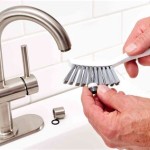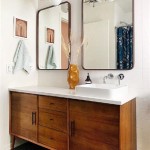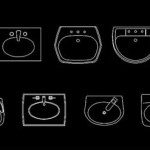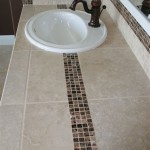Small Bathroom with Washing Machine and Dryer
Integrating a washing machine and dryer into a small bathroom presents unique design challenges. Careful planning and strategic choices are essential to maximize space and maintain functionality. This article explores various approaches to incorporating laundry appliances into compact bathrooms, emphasizing effective space utilization and practical design considerations.
Key Considerations for Small Bathroom Laundry Integration:
- Available Space Assessment
- Appliance Size and Configuration
- Ventilation Requirements
- Plumbing and Electrical Considerations
A thorough assessment of the available space is the crucial first step. Accurate measurements of the bathroom's length, width, and height are necessary. This includes noting the placement of existing fixtures like the toilet, sink, and shower/tub. Understanding the available floor space, wall space, and vertical clearance will inform appliance selection and placement options.
Choosing the Right Appliances:
- Compact Washer and Dryer Units
- Stackable vs. Side-by-Side Configurations
- All-in-One Washer-Dryer Combo Units
The size and configuration of the washer and dryer significantly impact the layout. Compact, front-loading units are generally preferred for small bathrooms due to their smaller footprint. Stackable units maximize vertical space, while side-by-side configurations may be more suitable if vertical clearance is limited. All-in-one washer-dryer combos offer a space-saving solution, although they typically have smaller load capacities.
Ventilation is Essential:
- Moisture Control
- Preventing Mold and Mildew
- Exhaust Fan Placement and Capacity
Adequate ventilation is paramount in a bathroom housing laundry appliances. The increased moisture generated by washing and drying clothes necessitates a robust ventilation system. A properly sized and positioned exhaust fan will help control humidity levels, preventing the growth of mold and mildew and minimizing potential damage to bathroom fixtures and finishes.
Addressing Plumbing and Electrical Needs:
- Water Supply Lines
- Drainage Requirements
- Electrical Outlets and Circuit Capacity
Existing plumbing and electrical systems may need adjustments to accommodate the laundry appliances. Ensuring adequate water supply lines and proper drainage is essential. Electrical outlets must be appropriately positioned and the electrical circuit must have sufficient capacity to handle the power demands of the washer and dryer. Consulting with qualified plumbers and electricians is recommended.
Optimizing Space and Storage:
- Over-the-Toilet Storage
- Wall-Mounted Cabinets
- Recessed Shelving
- Utilizing Vertical Space
Maximizing storage in a small bathroom with laundry appliances requires creative solutions. Installing shelves or cabinets above the toilet can utilize otherwise wasted space. Wall-mounted cabinets and recessed shelving offer additional storage without encroaching on valuable floor space. Utilizing vertical space with tall, narrow storage units can also be effective.
Design and Aesthetics:
- Color Palette and Lighting
- Creating a Cohesive Look
- Visual Expansion Techniques
The design and aesthetics of the bathroom should not be overlooked. A light and bright color palette can create a sense of spaciousness. Strategic lighting can enhance the visual appeal and functionality of the space. Choosing finishes and fixtures that complement the laundry appliances will create a cohesive and visually appealing environment.
Functionality and Accessibility:
- Ease of Use and Maintenance
- Clearance Around Appliances
- Ergonomic Considerations
Maintaining functionality and accessibility is crucial. Ensuring adequate clearance around the appliances allows for easy access and maintenance. Ergonomic considerations, such as the height of the appliances and the placement of controls, should be taken into account to ensure comfortable and convenient use. Careful planning and attention to detail will result in a small bathroom that efficiently incorporates both laundry appliances and essential bathroom fixtures.
Door and Traffic Flow Considerations:
- Door Swing and Clearance
- Optimizing Traffic Flow
- Pocket Doors or Sliding Doors
The bathroom door's swing and clearance should be considered when planning the layout. The door should not obstruct access to the appliances or impede traffic flow within the bathroom. Pocket doors or sliding doors can be space-saving alternatives to traditional swing doors, allowing for more efficient use of the limited space. Careful consideration of door placement and type will optimize the functionality and accessibility of the bathroom.
Soundproofing Considerations for Laundry Appliances:
- Vibration Dampening Pads or Mats
- Sound-Insulating Blankets or Enclosures
- Proper Installation Techniques
The noise generated by washing machines and dryers can be a concern, particularly in small bathrooms. Implementing soundproofing measures can mitigate this issue. Using vibration-dampening pads or mats under the appliances can reduce vibrations and minimize noise transmission. Sound-insulating blankets or enclosures can further dampen sound levels. Furthermore, ensuring proper installation techniques, including secure mounting and leveling, can contribute to quieter operation.

30 Smart Bathroom Design Ideas With Washing Machine To See More Read It Small Remodel Interior Apartment

Laundry Bathroom Combo Work Renovations Balnei Colina

Bathroom Washer Dryer Design Ideas

40 Bathroom Designs With Washing Machines Digsdigs

Adding A Washer Dryer To Small Bathroom

Washer Dryer Under Bathroom Sink Small Layout Tiny House

Bradsknutson Laundry Room Bathroom Small Rooms

Makeover On A Budget Small Bathroom Lowe S

43 Smart And Cool Bathroom Laundry Ideas Shelterness

Rectangular Bathroom Layout With Washer And Dryer
Related Posts







